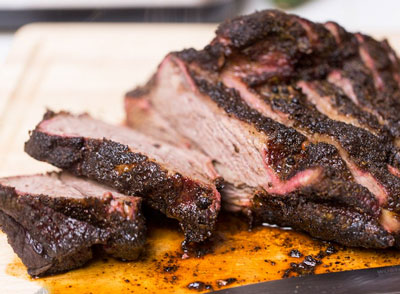Smoke signals {recipe}
Q. “Sometimes there is a pink ring on smoked foods—what is this? —Pete, Potosi
A. Well Pete, this phenomenon is known as a “smoke ring.” A smoke ring is a natural pink discoloration of the meat that is formed just under the surface of the meat. A smoke ring is caused during the smoking process by a chemical reaction between the nitrogen dioxide from the moist smoking wood with the natural nitrates in the meat. Most barbecue cooks try to achieve a smoke ring as a “badge of honor” that is expected by people who eat barbecue. There is absolutely no flavor value to a smoke ring, but since people eat with their eyes and usually expect to see it, it certainly enhances the visual appeal. Properly prepared barbecue will automatically have a beautiful smoke ring as a natural occurrence, but some barbecue rubs on the market include a touch of sodium nitrite, which aids in the production of a smoke ring. The crust, known as “bark” on the outside of a piece of barbecue, particularly beef briskets and pork shoulders, is much more important to the finished taste of the meat and cooks should pay more attention to the development of the bark than to the development of the smoke ring.
Am I making you hungry yet, Pete?
Chef Jeff’s Brisket Marinade
1 Large yellow onion, rough chopped
1/2 cup Oil, canola or other
2 cups Soy sauce
3/4 cup Worcestershire sauce
1 cup Brown sugar
1 tablespoon Garlic, granulated
1 tablespoon Black Pepper, table grind
Directions
1. Hard sweat the onions in the oil until soft. Puree the onions and the oil until a smooth, fine paste.
2. Add the soy sauce, Worcestershire sauce, brown sugar, granulated garlic and black pepper to the onion puree and combine thoroughly.
3. Place the beef brisket (or other product) in the marinade and allow to marinate for at least 12 hours.
4. Slow smoke the marinated beef brisket over indirect heat at 225 degrees for 12 hours.
5. Place the smoked brisket in a warm, steamy environment for 3 hours.
6. Remove exterior fat from the brisket. Slice and present for service. This flavor profile would do well complemented with a hearty, sweet barbecue sauce.










Leave a Comment